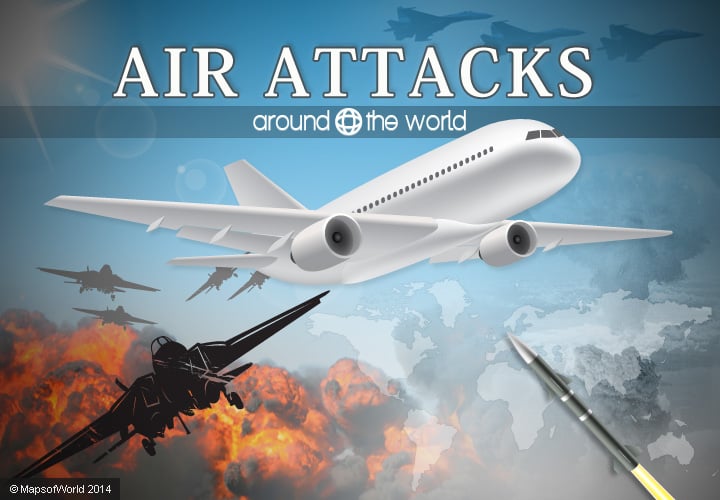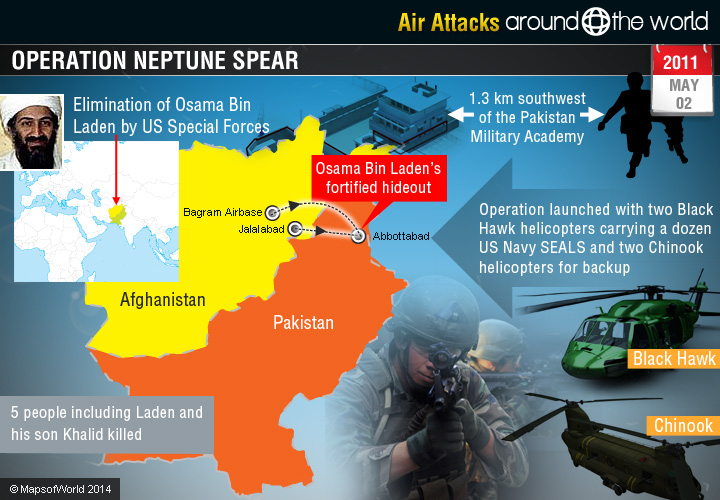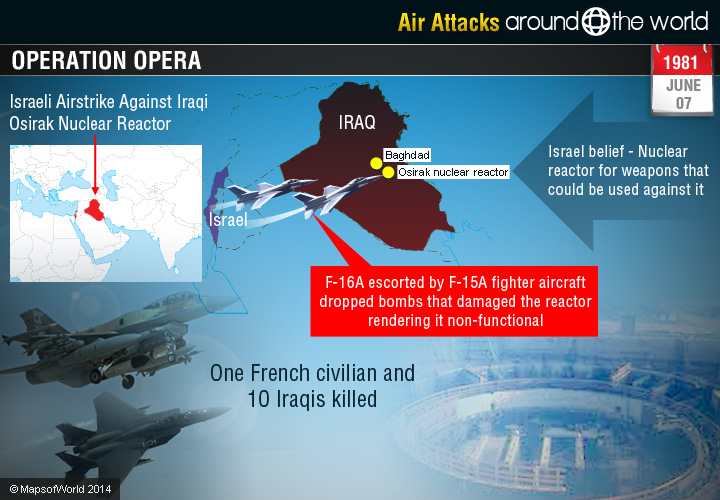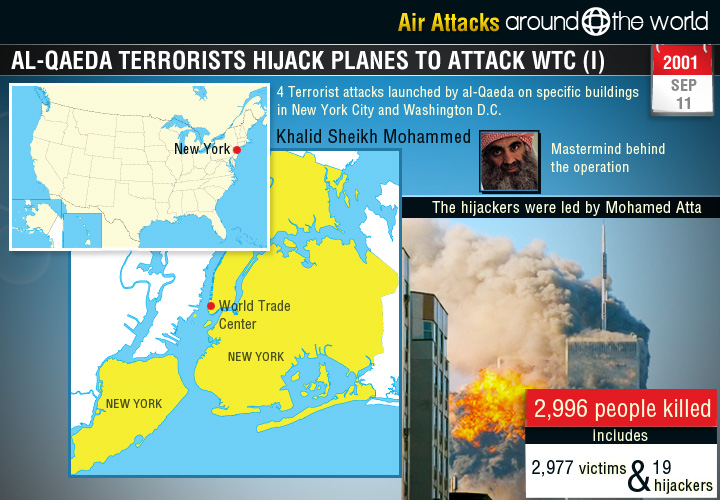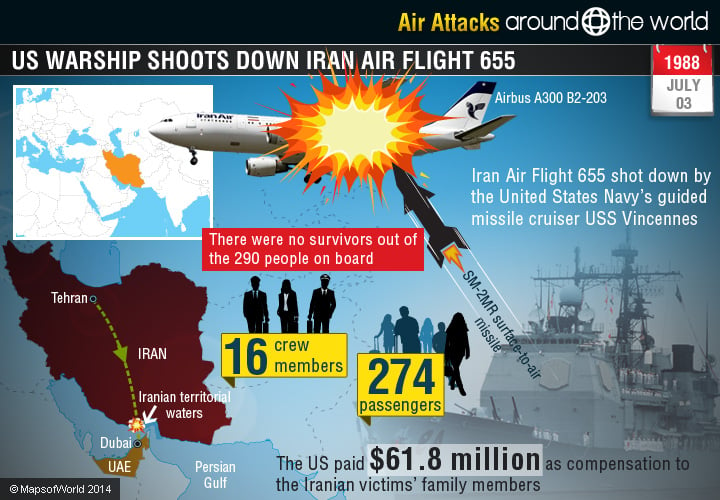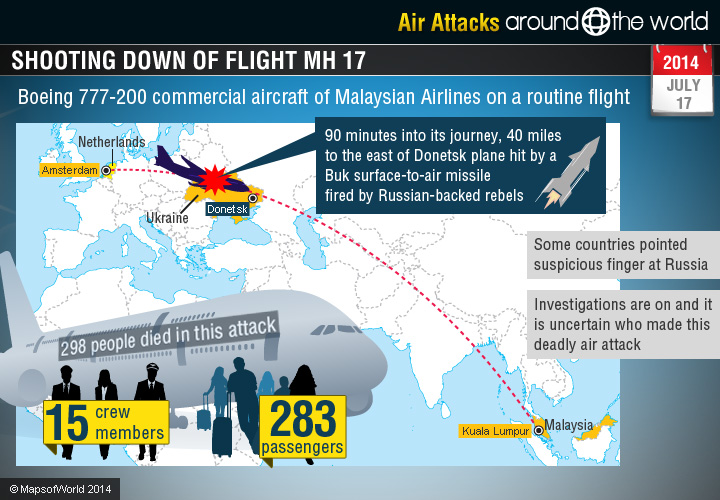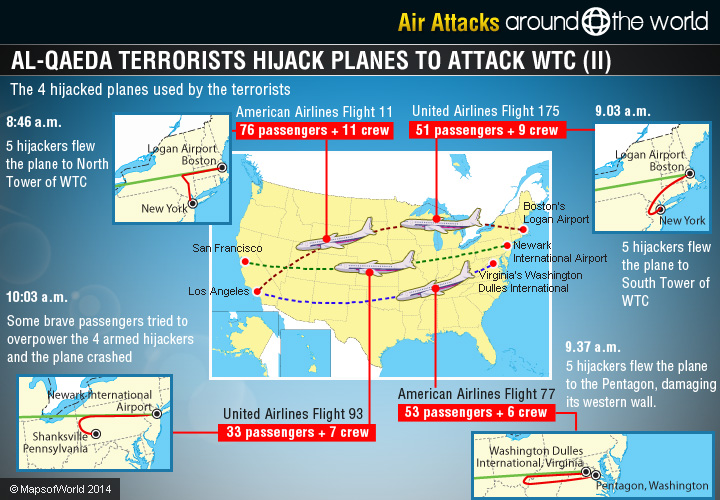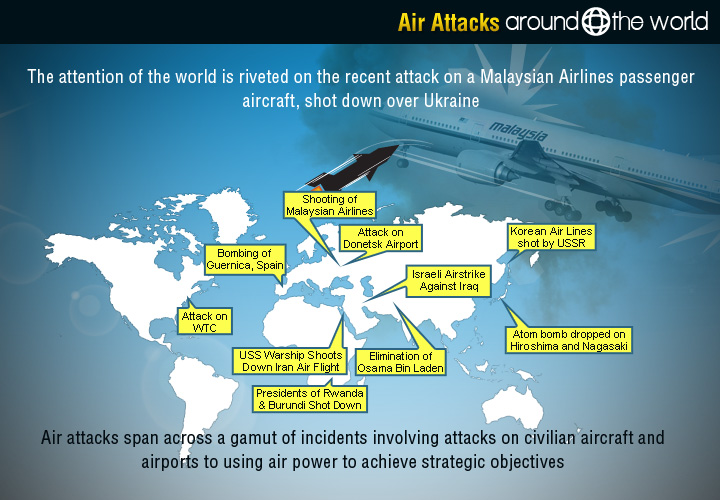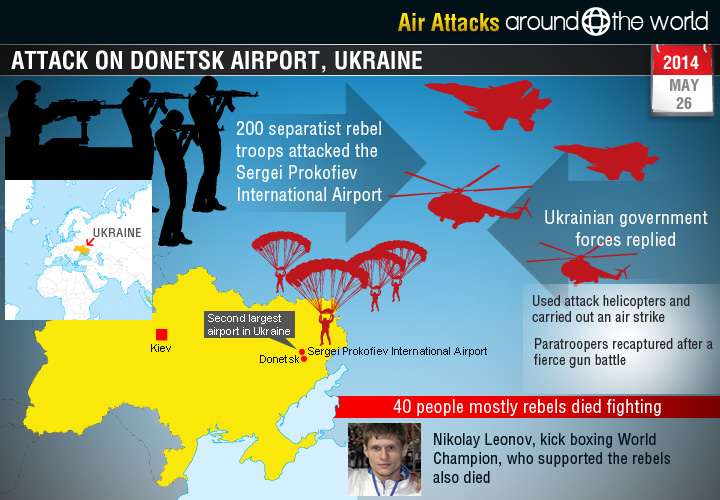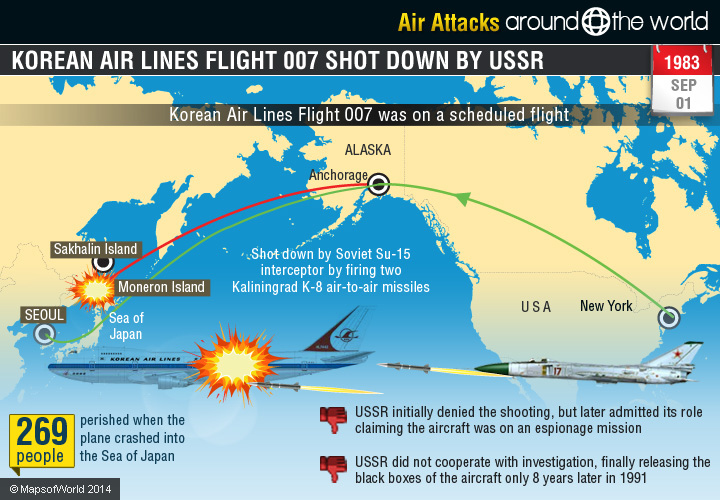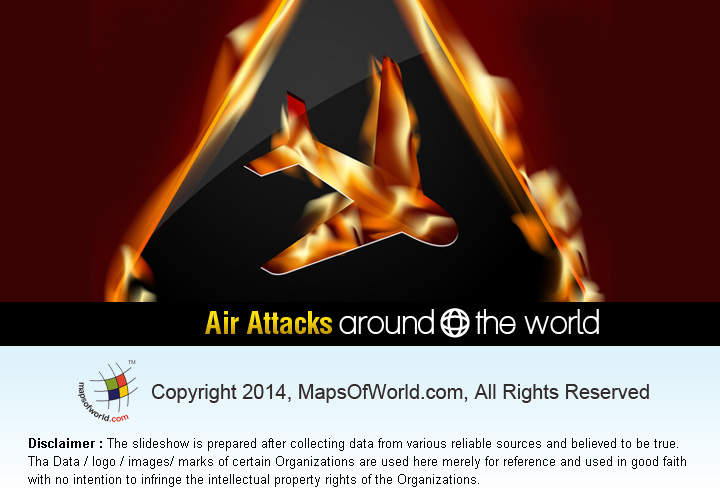Over the last century and this one, nations have used military power, including air power to extend their political objectives. From the Syrian air attacks, to Pearl Harbor to using air power to achieve strategic objectives – Air attacks span a gamut of incidents. Read on to know more about various air attacks that occurred around the world:
17 July 2014 – Shooting Down of Malaysian Airlines Flight 17 (MH 17)
On 17 July 2014, MH17, a Boeing 777-200 commercial aircraft operated by Malaysian Airlines was on a routine flight from Amsterdam in the Netherlands to Kuala Lumpur in Malaysia. About 90 minutes into its journey, while flying over Ukraine, when it was around 40 kilometers to the east of the city of Donetsk the plane was hit possibly by a Buk surface-to-air missile made by Russia and fired by Russian-backed rebels.
There were 298 people (283 passengers and 15 crew members) on board, none of whom survived this air attack. The bodies of the victims have been flown to Eindhoven in the Netherlands. International inspectors are trying to piece together the evidence from a vast debris field and have retrieved the flight data recorders (black boxes) of MH 17. While some countries have pointed the finger of suspicion at Russia, until the investigations are conclusive it is not certain who perpetrated this deadly air attack.
26 May 2014 – Attack on Donetsk Airport, Ukraine
About 200 separatist rebel troops attacked the Sergei Prokofiev International Airport in the Ukrainian city Donetsk in an attempt to capture and control this important transport hub. This is the second largest airport in Ukraine after the international airport in the Ukrainian capital Kiev. The pro-Russian rebels used mortars in an attempt to capture the airport and which had been closed for two months. The rebels, who are associated with the Donetsk People’s Republic, began their battle on 26 May 2014. The Battle of Donetsk Airport intensified as the Ukrainian government forces used attack helicopters and carried out an air strike against the separatists. Paratroopers were sent to recapture the airport and it was recaptured after a fierce gun battle. The Ukrainian government described it as an “anti-terrorist” operation.
The Ukrainian National Security and Defense Council chief Andriy Parubiy assured government leaders in Kiev that the airport was fully under Ukrainian government control on 27 May. The Mayor of Donetsk Oleskandr Lukyanchenko said that over 40 people had died in the fighting, most of whom were separatist rebels. The dead included the Kick Boxing World Champion Nikolay Leonov, who supported the Donetsk People’s Republic.
2 May 2011 –Operation Neptune Spear
The Elimination of Osama Bin Laden by US Special Forces on May 2, 2011, in an operation involving the use of tactical air support, US Navy SEALs, US Army special forces, and CIA operatives eliminated the world’s most wanted man, Osama bin Laden, the head of the Islamist terrorist group al-Qaeda. Flying from Afghanistan in helicopters, they raided his fortified hideout in Abbottabad, Pakistan, identified and eliminated him, took his body back to Afghanistan for further verification and then buried the body at sea from the US warship.
The operation was launched from Bagram Airbase in northeastern Afghanistan and a base at Jalalabad in eastern Afghanistan. The aircraft that took part in the raid were two Black Hawk helicopters carrying a dozen US Navy SEALS and much bigger two Chinook helicopters that provided backup. Further backup was provided by fighter jets and surveillance by drones. The barricaded compound where Osama bin Laden, some of his wives and children, and close personal associates lived was located just 1.3 km southwest of the Pakistan Military Academy in Abbottabad. Experts believe that the Pakistani intelligence chief was fully aware of his presence there.
In the course of Operation Neptune Spear, five people were killed – Osama bin Laden, his son Khalid, his courier Abu Ahmed al-Kuwaiti, al-Kuwaiti’s brother Abrar, and Abrar’s wife Bushra. The SEALS retrieved Osama bin Laden’s body, leaving the other four behind.
One Black Hawk helicopter was damaged while landing and had to be destroyed. The SEAL team flew out in the remaining Black Hawk and one of the two backup Chinook helicopters. Osama bin Laden’s body was verified further at a US base in Afghanistan and then buried at sea from USS Carl Vinson in the Persian Gulf. After the operation was over the Pakistani Army chief Ashfaq Parvez Kayani was informed by Chairman of the Joint Chiefs of Staff Michael Mullen about the raid.
11 September 2001 – al-Qaeda Terrorists Hijack Planes to Attack New York and Washington D.C.
On 11 September 2001 four terrorist attacks were launched by al-Qaeda on specific buildings in the metropolitan area of Washington, D.C and New York City. Almost 3,000 people were killed and property worth $10 billion was damaged.
The terrorist Khalid Sheikh Mohammed admitted to being the mastermind behind the operation that involved meticulous planning. Posing as flight students, 19 al-Qaeda operatives enrolled in flying schools in the US. They learnt to fly the civilian aircraft that they planned to hijack, take control of, and use in a suicidal terrorist strike in the heart of America. The hijackers were led by Mohamed Atta.
The four hijacked planes were:
- American Airlines Flight 11: From Boston’s Logan Airport to Los Angeles had 76 passengers and 11 crew. At 8:46 a.m., the five hijackers flew the plane into the North Tower of New York’s World Trade Center (WTC).
- United Airlines Flight 175: From Boston’s Logan Airport to Los Angeles had 51 passengers and nine crew. At 9:03 a.m., the five hijackers flew the plane into the South Tower of New York’s WTC.
- American Airlines Flight 77: From Virginia’s Washington Dulles International to Los Angeles had 53 passengers and six crew. At 9.37 a.m. the five hijackers flew the plane into the Pentagon, headquarters of the US Department of Defense, in Washington DC., damaging its western wall.
- United Airlines Flight 93: From Newark International Airport to San Francisco, had 33 passengers and seven crew on a flightpath for Washington D.C. Some of its brave passengers tried to overpower the four armed hijackers and the plane crashed near Shanksville, Pennsylvania, at 10:03 a.m.
The planes were chosen because long distance flights would have more fuel and would therefore, make for a larger and more destructive explosion.
A total of 2,996 people were killed, of which 2,977 were victims and 19 were hijackers.
Many buildings around the World Trade Center were also damaged or destroyed. The new One World Trade Center has been constructed in the space previously occupied by the WTC.
6 April 1994 – Airplane Carrying the Presidents of Rwanda and Burundi Shot Down
On 6 April 1994, the Dassault Falcon 50 aircraft carrying the president of Rwanda, Juvénal Habyarimana and the president of Burundi, Cyprien Ntaryamira was shot down, as it was coming in to land in Kigali International Airport in Rwanda.
The responsibility for the crash is still not certain though investigations have indicated the missile that brought down the plane was shot from an area controlled by Rwandan Patriotic Front (RPF) forces. The other possible suspects are Hutu extremists who were against the President’s negotiations with the RPF.
This twin assassination was one of the initiators for the Rwandan Genocide (April to July 1994) and the First Congo War (1996-97).
3 July 1988 – USS Warship Shoots Down Iran Air Flight 655
On 3 July 1988, Iran Air Flight 655 was enroute from Tehran to Dubai when it was shot down by the US Navy’s guided missile cruiser USS Vincennes. The civilian aircraft was flying over Iranian territorial waters over the Persian Gulf at the time on its scheduled flight path.
The Airbus A300 B2-203 was carrying 290 people on board, including 16 crew and 66 children. There were no survivors after the aircraft was hit by SM-2MR surface-to-air missiles fired by the USS Vincennes, which was in Iranian waters at the time. This tragedy is ranked seventh among the most fatal tragedies in aviation history.
This led to a major diplomatic incident where some analysts accused the captain of the US warship of aggressive and reckless behaviour.
Though the US government never formally apologized to the Iranian government, it arrived at a settlement in the International Court of Justice. The US paid $61.8 million (or $213,103.45 per passenger) as compensation to the Iranian victims’ family members.
The flight number IR655 is still used by Iran Air in commemoration of the victims on the Tehran–Dubai route.
1 September 1983 – Korean Air Lines Flight 007 shot down by USSR
On 1 September 1983, Korean Air Lines Flight 007 was on a scheduled flight from New York City to Seoul, via Anchorage in Alaska. While flying near Moneron Island, west of Sakhalin Island, in the Sea of Japan, it was shot down by a Soviet Su-15 interceptor of the erstwhile USSR.
Major Genadi Osipovich, was the pilot of the Su-15 fighter plane that fired two Kaliningrad K-8 air-to-air missiles at the civilian aircraft. The passenger plane was carrying 269 people, who perished when the plane crashed into the Sea of Japan.
The plane had inadvertently flown into Soviet airspace and the USSR initially denied the shooting, but later admitted its role claiming the aircraft was on an espionage mission. The USSR claimed the flight’s deviation from its path was a deliberate act of provocation.
The USSR did not cooperate with the investigation conducted by the International Civil Aviation Organization (ICAO), finally releasing the flight data recorders of the aircraft only eight years after the USSR fell apart in 1991.
This incident was one of the most fraught moments of the Cold War and led to an increased anti-Soviet attitude in the US.
7 June 1981 – Operation Opera: Israeli Airstrike Against Iraqi Osirak Nuclear Reactor
On 7 June 1981, the Israeli Defense Forces carried out Operation Opera (also called Operation Babylon), a pre-emptive strike against the Osirak nuclear reactor located 17 km southeast of the Iraqi capital, Baghdad.
Israel believed the nuclear reactor would be used to develop nuclear weapons that could be used against it. Iraq, however, maintained that the reactor, purchased from France, was meant for peaceful purposes, including scientific research.
The air raid was carried out by Israeli Air Force F-16A fighter aircraft, escorted by F-15A fighter aircraft. The F-16s dropped bombs that damaged the reactor rendering it non-functional. One French civilian and 10 Iraqis were killed in the attack.
While International Law case studies regard the Israeli air attack as an example of an effective pre-emptive strike, the Israeli action was condemned by resolutions of the United Nations Security Council and United Nations General Assembly.
6 August 1945 – Atom Bomb Dropped on Hiroshima, Japan, by the United States
During the Second World War, leading scientists in the United States were actively involved in the war effort, developing a nuclear weapon that could put an end to the war, through its sheer potential for destruction. Under the aegis of the US Defense establishment, the top-secret Manhattan Project headed by J. Robert Oppenheimer developed powerful nuclear weapons.
The first atom bomb, called “Little Boy”, was dropped on the Japanese city of Hiroshima on 6 August 1945. The bomb was loaded on a B-29 Superfortress bomber, piloted by Colonel Paul Tibbets whose crew received specialized training that included how to make a fast getaway, to avoid the shock waves emanating from the blast site.
While three targets were chosen, Hiroshima was picked as the site for the first nuclear bomb. Paul Tibbets’s B-29 bomber, called Enola Gay, took off from the US Pacific base of Tinian, early in the morning of 6 August. It dropped Little Boy (which weighed 4,406 kgs) over Hiroshima at 8.15 a.m.
Tibbet’s co-pilot saw the impact of the bomb on the city and said “My God, what have we done?” The death toll in Hiroshima was 90,000 to 166,000, of which about half died on the first day, and the effects of genetic damage caused by the radiation continued in the next generation.
9 August 1945 – Atom Bomb Dropped on Nagasaki, Japan, by the United States
After the nuclear bombing on Hiroshima on 6 August 1945, the US prepared for another airstrike against another Japanese city in order to reiterate the destructive capability of the atom bomb.
The next city chosen as the target was Kokura, however the cloudy weather made for poor visibility over the city, and the B-29 Superfortress bombers were diverted to Nagasaki, an industrial city on the island of Kyushu.
Called “Fat Man,” the second nuclear bomb was dropped by a B-29 called Bockscar, piloted by Major Charles W. Sweeney. The detonation of Fat Man, which resulted in the death of 39,000 to 80,000 people, following shortly after the atom bombing of Hiroshima on 6 August 1945, resulted in the unconditional surrender of Japan on 14 August 1945.
While causing immense destruction, the dropping of these two atom bombs also hastened the end of the Second World War.
7 December 1941 – Japanese Air Attack on Pearl Harbor
On 7 December 1941, in an attack that took the US by surprise the Japanese launched a sudden air strike from their aircraft carriers in an attempt to disable the US naval presence in the Pacific and increase their dominance of the region.
A total of 353 Japanese fighters, torpedo aircraft, and bombers appeared over the horizon and wreaked havoc on the battleships and their crew based in Pearl Harbor.
The US lost five battleships, three destroyers, three cruisers, one minelayer, over 200 aircraft, and 2,500 men in the surprise raid on Pearl Harbor.
Japan lost 65 men, five midget submarines, and 29 aircraft.
Luckily, three of the US Pacific Fleet’s aircraft carriers were not in the harbour at the time of the attack and escaped the air strike. The shallow water of the harbour also aided rescue and salvage efforts. While the Japanese attack on Pearl Harbor is studied by military strategists even today as an example of taking the enemy by surprise, the Japanese plan to contain the US backfired as the US President Franklin Delano Roosevelt described 7 December 1941 as a ‘Day of Infamy’ in the aftermath of the Japanese air attack. The very next day he declared the US was at war with Japan, and thus the US became an active participant in the Second World War.
26 April 1937 – Bombing of Guernica, Spain, by the Condor Legion
The Spanish Civil War which raged across Spain from 17 July 1936 to 1 April 1939 was fought between the Nationalists led by General Francisco Franco and the Republicans who supported a left-wing government. While the Republicans were aided by the Soviet Union, the Nationalists were aided by Germany, which sent about 19,000 volunteers who made up the Condor Legion, because they were mostly aviators.
Flying Heinkel He-111 bombers, the Condor Legion attacked the northern Spanish town of Guernica, on 26 April 1937, in a sudden air strike. In the short span of three hours, the bombers dropped 45,000 kgs of incendiaries and high explosive bombs.
Around 1/3rd of population of Guernica was killed, about 1,000 people were injured, and 70% of the town was destroyed. The aftermath of the bombing was that many European nations became more fearful of German military might and gave in to their intimidatory tactics. The legacy of Guernica also lives on in art as the subject of a famous anti-war painting titled Guernica, by the celebrated Spanish painter Pablo Picasso.

